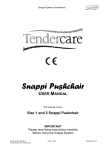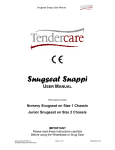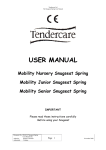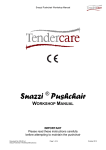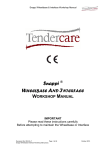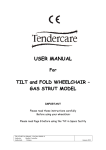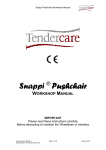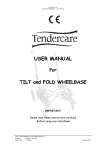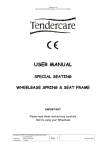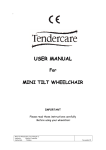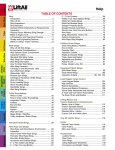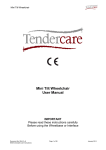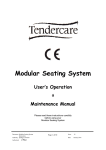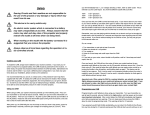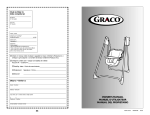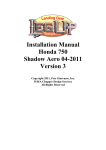Download Snappi Pushchair USER MANUAL
Transcript
Snappi System User Manual Snappi Pushchair USER MANUAL This manual covers: Size 1 and 2 Snappi Pushchair IMPORTANT Please read these instructions carefully Before using the Snappi System My Snappi Serial Numbers: TEN/SC………. TEN/SS……..... Document No: 053-05 v27 Snappi System User Manual.doc Page 1 of 74 September 2015 Snappi System User Manual Snappi Seat Unit Snappi Chassis Fig 0.1 Complete Pushchair (size 1 shown) Document No: 053-05 v27 Snappi System User Manual.doc Page 2 of 74 September 2015 Snappi System User Manual Push Handle Adjustor Tilt Lever Spring Loaded Locking Slider Brake Bar Fig 0.2 Chassis (size 1 shown) Adjustable Back Hip Guides Hip Belt Side Pads Knee Angle Adjustors Adjustable Base Playtray Mountings Footrest Interface Fig 0.3 Seat Unit (Size 1 shown) Document No: 053-05 v27 Snappi System User Manual.doc Page 3 of 74 September 2015 Snappi System User Manual Fig 0.4 Folded System - Complete (size 1 only) Fig 0.5 Folded System - 2 part fold (all models) Document No: 053-05 v27 Snappi System User Manual.doc Page 4 of 74 September 2015 Snappi System User Manual Item Description Page 1 Who to contact if you have difficulty 2 Introduction 7-9 3 Unpacking 3.1 Serial Numbers 9 - 10 10 4 Preparing the wheelbase for use 4.1.1 Unfolding the Frame (Original Locks) 4.1.2 Unfolding the Frame (Spring Loaded Locks) 4.2A Original Brakes (pushchairs supplied before June 2015) 4.2B Pin Brakes (pushchairs supplied after June 2015) 4.2C Tyres 4.3 Fitting the seat to the chassis 4.4 Using the Tilt In Space facility 4.5 Folding as a complete system (size 1 only) 4.6 Folding as a 2 part system (all models) 10 - 18 11 - 12 12 - 13 14 14 - 15 15 16 – 18 19 20 20 5 Setting up the seat unit 5.1 Adjusting the seat unit 5.1.1 Seat Depth and Hip Guides 5.1.2 Footrest Depth and Knee Angle Adjustment 5.1.3 Back height and recline angle adjustment 5.1.4 Lateral Supports (Optional) 5.2 Fitting and removing the cover 5.3 Fitting a Headrest Pad or Lateral Head Supports (optional) 5.4 Fitting the Pelvic Strap 5.5 Fitting a Groin Adaptation Strap 5.6 Fitting a Butterfly/Chest Harness or H-Belt Harness 21 – 36 22 22 23 24 25 - 26 26 – 27 27 – 28 29 – 30 31 32 – 35 6 Accessories 6.1 Shopping Basket 6.2 Equipment Carrying Tray 6.3 Sun Canopy 6.4 Sun Hood and Transparent Rain Shield 6.4b New Style Sun Canopy Fixings 6.4c Removing the Cover For Washing 6.5 Rain Cover 6.6 Frame Padding 6.7 Grip Rail 6.8 Playtray 36 – 50 36 37 38 – 39 40 – 43 44 – 46 46 – 48 49 50 50 51 – 53 Document No: 053-05 v27 Snappi System User Manual.doc Page 5 of 74 7 September 2015 Snappi System User Manual 6.9 Pommel 6.10 Ramped Seat Pad 6.11 Foot Muff 6.12 Ankle Huggers 6.13 Toe and Heel Straps 6.14 Vertical Cylinder Carrier 53 – 54 54 – 55 55 – 57 58 – 59 59 – 61 61 – 62 7 User Instructions 7.1 Getting into the Snappi Pushchair 7.2 Getting out of the Snappi Pushchair 62 62 62 8 Attendant pushing 8.1 Pushing 8.2 Brakes 8.3 Comfort 8.4 Lifting and general safety 63 63 64 64 65 9 Cleaning 9.1 Buggy and seat unit 9.2 Seat Cover 9.3 Pelvic strap & harnessing 65 65 65 65 10 Maintenance 10.1 Routine maintenance 10.2 Six-monthly maintenance 66 66 66 – 67 11 Oxygen Cylinder 67 12 Warranty 68 13 Transporting the Wheelbase 13.1 Preparing the system for transport 13.2 Attaching wheelbase to vehicle 14 Repairs Document No: 053-05 v27 Snappi System User Manual.doc 69 69 – 71 71 – 73 74 Page 6 of 74 September 2015 Snappi System User Manual 1: Who to contact in difficulty Tendercare Ltd. PO BOX 3091, Littlehampton, BN16 2WF Tel: (01903) 726161 Fax: (01903) 734083 Email: [email protected] Web: www.tendercareltd.com 2: Introduction The Snappi is a highly adjustable pushchair designed to accommodate a wide variety of special seating needs. The pushchair system comprises a wheelbase and a seating unit, which is easily removable for storage and transport thanks to its integrated interface. The system is available in 2 sizes. The Wheelbase is made of a strong and lightweight aluminium alloy, minimising weight and providing a very rugged frame. The wheelbase provides a tilt in space facility and has 2 fixed rear wheels and 2 castor wheels at the front for easy steering. The Seat unit offers best in class growth, thanks to its versatile design and large ranges of adjustments to all supports. It has an easy to remove, breathable cover, and comes supplied with a hip belt as standard. Seat adjustments (please see table below for details of adjustment ranges): Seat depth adjustment, depth and length adjustable Hip Guides, Back Height adjustment, Independent back recline (using an easy to operate gas strut mechanism) and depth & angle adjustable Footrest. The seat also includes an interface allowing it to be quickly fitted and removed from the wheelbase, and like the entire Snappi range, includes all the latest safety mechanisms (including an innovative 2 stage release to prevent little fingers causing accidents). The following accessories for use with the Snappi Pushchair are available from Tendercare Ltd. Wheelbase Accessories: Equipment carrying tray, Shopping basket, and Rain-hood. Seat Accessories: Height and width adjustable wrap around Lateral Supports, Butterfly chest harness, Foot and Toe Straps, Pommel, Play Tray, Lateral Head Supports, Standard Headrest, Extra recess Headrest, and Occipital roll Headrest. These instructions apply to all sizes. A child’s safety is your responsibility. As such we recommend that you read the complete user manual prior to using your pushchair. Document No: 053-05 v27 Snappi System User Manual.doc Page 7 of 74 September 2015 Snappi System User Manual Snappi Seat Adjustments Support Seat Depth Seat Width Backrest Height Footrest Depth Back Recline Angle Knee Angle* Total System Weight Maximum Carry Weight Snappi Pushchair Size 1 195-295mm 190-290mm 500-675mm 150-280mm 90°- 135° -15°- 90° 19Kg 40Kg Snappi Pushchair Size 2 290-390mm 250-350mm 590-760mm 215-360mm 90°- 135° -15°- 90° 22Kg 40Kg IMPORTANT: * Knee angle adjustable in 15° increments ** Maximum carry weight includes the occupant and all accessories. Dimensions (mm) A B C Document No: 053-05 v27 Snappi System User Manual.doc Snappi Pushchair (Open) Size 1 Size 2 944 960 571 684 992 998 Page 8 of 74 September 2015 Snappi System User Manual Snappi Wheelbase Folded Size 1 Size 2 771 798 571 684 573 560 Dimensions (mm) A B C Please note sizes for complete pushchair are not given, as overall size of pushchair is dependant on the specific settings of the seat. All sizes and weights are given as a guide. Tendercare ltd reserves the right to amend specifications at any time as part of their product development programme. 3: Unpacking The wheelbases and seat unit are delivered together in a cardboard carton. This measures 680mm wide x 480mm deep x 1030mm high and weighs approximately 18Kg (size 1) or 20Kg (size 2). WARNING: The transit carton is quite bulky so moving and unpacking must be done with care. Observe all lifting and handling regulations. Stand the carton upright making sure it is supported and cannot fall over. Open the carton and remove any packages or packing, which could obstruct the removal of the seat and wheelbase. Remove the seat first, then the wheelbase. Do not attempt to lift both parts out together. The carton should contain the following items: Item 1 2 3 4 Component QTY. Size 1 or 2 Wheelbase Size 1 or 2 Seat Unit User Manual 5mm Alan key Document No: 053-05 v27 Snappi System User Manual.doc Yes No 1 1 1 1 Page 9 of 74 September 2015 Snappi System User Manual The following items should be fitted to the seat as standard: Item 5 6 7 8 9 Component QTY. 2 1 1 2 1 Hip guide covers Seat Base Cover Seat Back Cover Side Pads Hip Belt Yes No Please note, accessories such as lateral supports or harnessing that were ordered at the same time as the pushchair will be included in the main package. Larger accessories will be packaged in separate cartons (e.g. the rain cover). IMPORTANT: If any items are damaged or missing, then please contact Tendercare, preferably by email at [email protected] or alternatively please call us on (01903) 726161 within 36 hours of delivery. After unpacking and checking you have all components and they are in good condition dispose of the packaging at your local recycling centre. Alternatively retain and reuse. 3.1: Serial Numbers It may be a good idea, at this point, to make a note of your Snappi serial numbers on the front of your user manual as you will require these if you wish to purchase any accessories from Tendercare. There will be two serial numbers on your buggy – one for the chassis and one for the seat. However, if your buggy was purchased on your behalf by Wheelchair Services or another organisation, it may have other numbers put on by them as well. The ones we require are a TEN/SC…. and a TEN/SS…. The SC one is located on the chassis (on the bar between the two rear wheels and will look like TEN/SC1234) and the SS one is located on the seat (when the seat is in the buggy, where the back and seat join and will look like TEN/SS1234). 4: Preparing the wheelbase for use WARNING: When opening or folding the wheelbase, ensure that you hold the frame so that you avoid any danger of catching your fingers in moving parts. Keep children clear of the wheelbase during opening and folding. Document No: 053-05 v27 Snappi System User Manual.doc Page 10 of 74 September 2015 Snappi System User Manual 4.1.1 Unfolding the Frame (original locks) Fig 4.1.1.1 Standing at back of the wheelbase, place your foot on the rear cross member X (see Fig 4.1.1.1) and lift handle labelled Y as far as it will move. This will open the frame. Fig 4.1.1.2 Next locate the 2 plastic locking sliders (See Fig 4.1.1.2). These will be stowed in the “open” position and are held in place by 2 small spring clips. Fig 4.1.1.3 Press the 2 silver “Spring pins” in and slide the 2 locking pieces down over the lower tube sections. (See Fig 4.1.1.3) Fig 4.1.1.4 The pins will spring through the holes in the sliders and hold them in place (see Fig 4.1.1.4). Document No: 053-05 v27 Snappi System User Manual.doc Page 11 of 74 September 2015 Snappi System User Manual WARNING: If the locking sliders are not in the correct position, or the spring pins do not protrude thereby allowing the locking clips to move back up the frame, then the frame may collapse in use. Folding the wheelbase: To unlock the frame and fold the wheelbase, reverse the above instructions. 4.1.2 Unfolding the Frame (Spring loaded locks) Fig 4.1.2.1 Standing at back of the wheelbase, place your foot on the rear cross member X (see Fig 4.1.2.1) and lift handle labelled Y as far as it will move. This will open the frame. Fig 4.1.2.2 Once the frame is almost open, the 2 plastic frame locks will engage with the angled sections of the lower frame. Continue to unfold the frame; this will force the locks up the tubes. There will be some resistance, as you will be working against the locking springs. Fig 4.1.2.3 Once fully open, the frame locks will snap shut over the front frame, securing the frame in the open position. Always check that both locks are fully closed. In the locked position the guide bolt ‘B’ will be sat in the top of the slot ‘A’ on the side of the slider as shown (see Fig 4.1.2.3). If there is any slot visible above the guide bolt, push the lock down by hand until it will not move any further. Document No: 053-05 v27 Snappi System User Manual.doc Page 12 of 74 September 2015 Snappi System User Manual Fig 4.1.2.4 To fold the frame: Standing beside the frame, pull up the 2 locking sliders as shown (see Fig 4.1.2.4). Whilst holding the locks open, push down with your arm on the upper frame or push handle, so that the frame starts to fold. Release the locking sliders, and fold down the frame by moving the push handle down as far as it will move. IMPORTANT: Always check that BOTH frame locks are fully closed before using the frame. If they are not properly engaged, the frame could collapse during use. Document No: 053-05 v27 Snappi System User Manual.doc Page 13 of 74 September 2015 Snappi System User Manual 4.2A Original Brakes (pushchairs supplied before June 2015) Fig 4.2.1 To apply the brake, put your foot on the top of brake bar (labelled X) and push down as shown. The brake will flip down onto the wheels and lock them. To release the brake, hook your foot between the middle raised portion of the brake bar, and the frame cross bar. Then, lift the brake bar with your foot until it flips back and stops against the brake stop pins. Please note you may find it easier to use your hand to release the brake. If operating the brake by hand always hold the brake by the raised section in the middle of the bar. Fig 4.2.2 Important: Always put the brake on when placing the child in, or taking them out of the pushchair. Do not leave the brake on when the pushchair is not in use as this will damage the rear wheels. WARNING: The brake mechanism is spring loaded so care must be taken when operating it. When operating the brake mechanism ensure that you always keep a firm hold of the pushchair, keeping your hands well away from the brake mechanism. Do not leave the pushchair on a slope, even with the brake on. Always ensure that the pushchair is on level ground to prevent risk of injury to the occupant. 4.2B Pin Brake (pushchairs supplied after June 2015) Snappi Pushchairs supplied after June 2015 will be fitted with the new Pin Brake mechanism. Fig 4.2.3 Document No: 053-05 v27 Snappi System User Manual.doc To set the pin brake, first securely hold the push handle. Place your foot on the top of the push bar as shown (see Fig 4.2.3, left) then press the bar down as far as it will go. If the brake is stiff, try rolling the pushchair forward slightly to help line up the pins with the locking rings on the wheels. Page 14 of 74 September 2015 Snappi System User Manual Fig 4.2.4 Right: The brake in the fully locked position. Fig 4.2.4 To release the pin brake, hold the pushchair and place your foot underneath the brake bar as shown (see Fig 4.2.5, left). Lift the bar as far as it will move to ensure the pins are clear of the locking rings. Fig 4.2.5 Warning: When operating the brake mechanism ensure that you always keep a firm hold of the pushchair and keep your hands well away from the brake mechanism. Do not leave the pushchair on a slope, even with the brake on. Always ensure that the pushchair is on level ground to prevent risk of injury to the occupant. 4.2C Tyres: As standard the Snappi pushchair is supplied with solid tyres, however pneumatic tyres are also available as an option. If your pushchair is supplied with pneumatic tyres these need to be regularly checked and inflated if necessary using a hand or foot pump. The operating pressure for the tyres is 36 PSI (note: do not inflate the tyres above 36 PSI). Do not use high pressure air lines or mechanical pumps as used in garages, to inflate the tyres. Document No: 053-05 v27 Snappi System User Manual.doc Page 15 of 74 September 2015 Snappi System User Manual 4.3 Fitting the seat to the chassis The seat incorporates an Interface system, and includes a 2-stage latch that comprises a main latch and a second safety latch that prevents accidental release of the seat from the chassis. The safety catch must be correctly set before the main catch can be operated: How to operate the safety catch: Fig 4.3.1 The safety catch clip is located under the front right corner of the seat near to the release lever. Definition of components: X: Pull handle Y: Locking Pin Safety Catch Locked Fig 4.3.2 To release it, pull the handle “X”, and turn it 90 degrees so that the pin “Y” is fully retracted. To lock it, pull “X” and turn 90 degrees in the opposite direction, so that pin “Y” is fully protruded and sits behind the interface main catch “B” (see fig 4.3.3 on next page). Safety Catch unlocked Important: When fitting or removing the seat, the carer / parent must first ensure that the safety catch pin is set in the “unlocked” position. It will not be possible to fit or remove the seat if the latch is “locked”, and attempting to do so may cause damage to the chassis or the seat. Once the seat has been fitted, the carer / parent must always lock the safety catch. Note: A warning label is positioned on the front right hand portion of the tilt frame on the chassis, to remind carers to lock the safety catch. Document No: 053-05 v27 Snappi System User Manual.doc Page 16 of 74 September 2015 Snappi System User Manual To fit the seat to the frame: Definition of interface mounting points: A: Seat Interface Rear Hooks B: Seat Interface Main Clips Fig 4.3.3 C: Seat Interface Safety Catch D: Seat Interface Release Handle E: Frame interface rear bushings F: Frame interface front bushings Fig 4.3.4 Ensure that the safety catch “C” has been unlocked (see instructions on previous page). Holding the seat as shown, tilt it back and locate the 2 rear hooks “A” on the back of the interface, over the stainless steel bushings on the back of the frame interface “E”. Fig 4.3.5 Next, rotate the seat forward and down so that the main clips “B” snap over the front stainless steel bushes on the frame interface “F”. Note that due to the design of the frame interface, it is not possible to fit the seat backwards. If fitted the wrong way around the clips will not close and it will not sit down into the frame. Fig 4.3.6 Document No: 053-05 v27 Snappi System User Manual.doc Page 17 of 74 September 2015 Snappi System User Manual Next, push down firmly on the release lever “D” to ensure that the clips are fully closed. Note the lever is positioned under the front right corner of the seat (see Fig 4.3.7). Set the safety catch “C” to the “Locked” position (so that the pin sits behind the interface clip). Fig 4.3.7 To remove the seat, first unlock the safety catch “C” as detailed above. Lift the release lever “D” up, whilst holding the top of the seat with your other hand. This will open the main clips “B”. Rotate the seat back so that the main clips are clear from the frame, and lift the seat away from the buggy. Fig 4.3.8 IMPORTANT: Always ensure that the seat interface clips are fully closed. To test this, press down on the release lever when fitted and make sure the clips will not move (see fig 4.3.5). Always lock the safety catch before using the buggy. Always unlock the safety catch before fitting or removing the seat. Attempting to fit or remove the seat with the catch locked could cause damage to the seat or the chassis. Do not attempt to fit the seat backwards. It will not lock in a rearward facing position. The seat interface system is spring loaded, so ensure your fingers are clear of the clips when fitting or removing. Document No: 053-05 v27 Snappi System User Manual.doc Page 18 of 74 September 2015 Snappi System User Manual 4.4 Using the Tilt in Space facility Fig 4.4.1 To operate the tilt in space mechanism, place your hand over the push handle adjustor, and lift the lever ‘L’ (see Fig 4.4.1) as shown. Fig 4.4.2 This will open the gas strut and tilt the seat. Note; The speed of tilt can be controlled by varying the pressure applied at lever L. Use your other hand to support seat as it tilts. Fig 4.4.3 To reset the tilt mechanism, hold down lever L and push down firmly on the front of the seat as shown (see Fig 4.4.3). Once in the desired position, release lever L. For a 90degree position, move the seat so the gas strut is fully closed and it will not move any further before releasing the tilt lever. IMPORTANT: Always ensure any harness provided for the child is used and correctly adjusted before reclining or returning the seat to a more upright position. Always support the seat when tilting, as the gas springs can be quick to operate. If the seat is not supported, is may move swiftly and could cause the occupant distress. Document No: 053-05 v27 Snappi System User Manual.doc Page 19 of 74 September 2015 Snappi System User Manual 4.5 Folding as a complete system (size 1 only) – Not suitable for rearward facing model First, set the seat to full tilt in space as detailed in section 4.4 Next fold the chassis as described in section 4.1 without removing the seat. Fig 4.5.1 Next, set the seat back angle to its maximum position as shown (see instruction on section 5.1.3). Fig 4.5.2 Finally, fold the footrest, and tuck it in using the knee angle adjustors as shown (see section 5.1.2 for details). Fig 4.5.3 4.6 Folding as a 2 part system (all models) – Including rearward facing model To fold the system as a 2 part, first set the seat back angle to 90o (see section 5.1.3), remove the seat and fold the frame as detailed in section 4.1. Next place the seat, face down over the folded chassis as shown. Fig 4.6.1 Document No: 053-05 v27 Snappi System User Manual.doc Finally, fold the footrest tray and angle the footrest tubes to sit closer to the seat (see section 5.1.2 for how to adjust and fold the footrest). Page 20 of 74 September 2015 Snappi System User Manual 5.0 Setting up the seat unit When setting up the seat unit always ensure the following is done: • Always consult your Therapist or Rehabilitation Engineer for advice. • Ensure that the child is relaxed and happy and if possible in an environment in which they are familiar. • If possible, sit the child on a plinth to take the measurements listed below: Measurement Top of head to seat Under armpit to seat (Axilla height) Actual sitting depth Chest Width (Arm pit to arm pit) Hip width Leg drop Number (see fig 5.0.1) 1 Millimetres 2 3 4 5 6 Fig 5.0.1 Definition of measurements Note: you can now adjust the seat to suit your child’s dimensions Document No: 053-05 v27 Snappi System User Manual.doc Page 21 of 74 September 2015 Snappi System User Manual 5.1 Adjusting the seat unit Common adjustments on the Snappi Seat can be made by hand (such as back height and back recline angle) and require no tools. Less frequent adjustments are made using a 5mm hexagon key (supplied), such as the seat depth and width. No other tools are required to make adjustments to the seat. 5.1.1 Seat Depth and Hip Guides To adjust the seat depth and width, first remove the seat base cover (this is attached by Velcro in the centre of the seat and is easily removed by pulling it away from the frame). Using the supplied 5mm hexagon key, loosen the 4 seat fixings. Next set the seat width (‘A’ see Fig 5.1.1.1) as measured in section 5.0 by sliding the hip guide brackets in or out as required. To adjust the seat depth (‘B’ see Fig 5.1.1.1), slide the upper of the base plates forward or back to achieve the required position. Once adjusted, tighten the 4 bolts using the hexagon key and fit the cover back into place. Fig 5.1.1.1 The Snappi hip guide also offers depth adjustment (‘C’ see Fig 5.1.1.2) to best suit your child’s needs. To adjust this, remove the hip guide cover. This is done by unclipping the two “poppers” and lifting the cover off the plastic plate. Next, use the 5mm hexagon key to loosen the 2 fixings, and slide the plate into the desired position as shown (see Fig 5.1.1.2). Once adjusted, tighten the 2 fixings and refit the hip guide cover. Fig 5.1.1.2 Document No: 053-05 v27 Snappi System User Manual.doc Page 22 of 74 September 2015 Snappi System User Manual 5.1.2 Footrest Depth and Knee Angle Adjustment To adjust the foot depth, loosen the 2 securing bolts (size 1) using the 5mm hexagon key as shown (see Fig 5.1.2.1). On some size 2 models, wing nuts may be fitted in place of bolts, and therefore the adjustment can be made by hand. Slide the footrest up or down the guide tubes to the required height as measured in section 5.0 Once set, lock the position by tightening the 2 fixing bolts / wing nuts. Fig 5.1.2.1 To adjust the knee angle, press in the angle adjustors on both sides of the footrest at the same time (see Fig 5.1.2.2), and lift the footrest guide tubes to the required angle. To lock, release the buttons. Note that the adjustors can only be locked in 15° increments. For the rearward facing Snappi it may be necessary to reduce the length of the footrest stems to avoid the footrest catching and inadvertently operating the brake bar. Alternatively the buggy can be placed in some degree of tilt and space to avoid this situation. Document No: 053-05 v27 Snappi System User Manual.doc Page 23 of 74 Fig 5.1.2.2 September 2015 Snappi System User Manual 5.1.3 Back height and recline angle adjustment To adjust the back height, first un-tuck the cover from the bottom of the seat (the cover doesn’t need to be removed). Next, turn the 2 large central hand wheels on the back plate, as shown in Fig 5.1.3.1, anticlockwise by either half a turn or, if necessary, one full turn. Hand Wheels Once these are loose, raise or lower the upper section of the back to the required height, and turn the 2 hand wheels clockwise until tight to lock it back into place. Once adjusted, tuck the cover back around the bottom of the seat with the excess sitting between the lower back plate and the gas spring. N.B. Before adjusting the back height you may need to remove any lateral trunk supports and/or the top straps of any chest harnessing. Fig 5.1.3.1 To adjust the back angle, grip the adjustment lever and lift it up, whilst holding the rear cross bar with your thumb. (See Fig 5.1.3.2) Rear Cross Bar To recline the seat, pull the top of the seat backwards to the required angle, and release the adjustment lever. To bring the seat back to a 90° position, pull the release lever and gently lift the seat (the gas spring will assist in returning the seat). Once at the required angle, release the adjustment lever. Adjustment Lever Fig 5.1.3.2 Document No: 053-05 v27 Snappi System User Manual.doc Page 24 of 74 September 2015 Snappi System User Manual 5.1.4 Lateral Supports (Optional) Fig 5.1.4.1(Lateral Trunk Supports with Chest Belt) Fig 5.1.4.1(Lateral Trunk Supports) The lateral trunk supports are supplied with two M8 coach bolts, and two 30mm hand wheels per bracket (see Figs 5.1.4.1and 5.1.4.2). To fit the laterals: The laterals are fitted by securing with coach bolts and hand wheels, through the mounting slots ‘H’ (see Fig 5.1.4.3) on the back of the seat unit. H Fig 5.1.4.3 The lateral bracket must be fed through the slot in the cover (see Fig 5.1.4.4). Next, insert the 2 coach bolts through the bracket and seat back plate, so that the square neck is sitting fully in the slots. Fig 5.1.4.4 Document No: 053-05 v27 Snappi System User Manual.doc Page 25 of 74 September 2015 Snappi System User Manual Finally, secure the laterals by screwing the provided hand wheels onto the protruding threads of the coach bolts (see Fig 5.1.4.5). The position of the laterals can be adjusted laterally by loosening the hand wheels and sliding them in or out to the required width. They can be adjusted vertically by sliding up and down the mounting slots ‘H’(see fig 5.1.4.3). There is a partition in the slots between the upper and lower back plates. To achieve the full adjustment range, the laterals need to be fitted in the appropriate section of the slots. Fig 5.1.4.5 5.2 Fitting and removing the cover To remove the seat pad: Simply lift the front edge of the seat pad to separate it from the Velcro strip on the base. Fig 5.2.1 To remove the hip guide covers: The cover hooks around the front of the hip guide plate. To remove, lift and rotate the cover from the rear as shown, and then unhook the cover from under the front of the hip guide plate. Fig 5.2.2 Document No: 053-05 v27 Snappi System User Manual.doc Page 26 of 74 September 2015 Snappi System User Manual To remove the side pads: Undo the 2 ‘popper’ fasteners, (See Fig 5.2.3) and unpeel the Velcro securing the pad. The pad will then be free to remove. Fig 5.2.3 To remove the back pad: Undo the 2 ‘popper’ fasteners located on the top left and right corners of the seat (see right). Next unhook the top of the back pad from the seat, and then un-tuck the material from around the bottom of the seat back plates to release the cover. Fig 5.2.4 5.3 Fitting a Headrest Pad or Lateral Head Supports (optional) To fit a headrest pad: There are three types of one piece headrest available; standard, extra recess (Fig 5.3.1) and occipital roll, however these can all be fitted to the seat in the same way. The headrest pads include a pair of Velcro securing straps. Fig 5.3.1 The headrest is fitted to the cover, through the upper fitting slots (see Fig 5.3.2). Fig 5.3.2 Document No: 053-05 v27 Snappi System User Manual.doc Page 27 of 74 September 2015 Snappi System User Manual First, remove the seat back pad from the frame (see section 5.2). Next, feed the Velcro straps though the slots, and join together to secure the headrest in place. Fig 5.3.3 Finally, refit the seat back pad to the seat frame. Fig 5.3.4 The lateral head supports are supplied with two M8 coach bolts, and two 30mm hand wheels per bracket (see Fig 5.3.5) To fit the head supports: The lateral head supports are fitted by securing with coach bolts and hand wheels, through the mounting slots ‘I’ (see Fig 5.3.6) on the back of the seat unit. Fig 5.3.5 The position of the laterals can be adjusted laterally by loosening the hand wheels and sliding them in or out to the required width. They can be adjusted vertically by sliding up and down the mounting slots ‘I’(see fig 5.3.6). I Fig 5.3.6 Document No: 053-05 v27 Snappi System User Manual.doc Page 28 of 74 September 2015 Snappi System User Manual 5.4 Fitting the Pelvic Strap Unless a 4-point pelvic strap (Fig 5.4.2) is ordered, the seat will come provided with a 2-point pelvic strap (Fig 5.4.1) fitted as standard. Fig 5.4.1 (Supplied as standard) Top Straps The pelvic strap should be fitted to the seat such that the 2 padded areas are facing the back of the seat (so that they will be against the child when he / she is in the seat) Fig 5.4.2(Optional Extra) To fit the 2-point pelvic strap to the old-style Snappi, (which can be distinguished by having only one cam-lock buckle on each side): Open the cam-lock buckles (these are located on the bottom left and right corners of the seat base). Feed the webbing of the strap through the cam lock. (See Fig 5.4.3) Fig 5.4.3 Adjust the length of the pelvic strap by pulling the webbing through the cam buckle until it is at the required length. (Fig 5.4.4) Once adjusted, lock the cam buckle on both sides to secure the strap. Important: The pelvic strap must be located as low down over the hips as possible. It must not cross the stomach of the passenger. Fig 5.4.4 Document No: 053-05 v27 Snappi System User Manual.doc Page 29 of 74 September 2015 Snappi System User Manual To fit the 2-point pelvic strap to the newstyle Snappi, (which has 3 cam buckles on each side: Open the middle cam-lock buckles (these are located on the bottom left and right corners of the seat base). Feed the webbing of the strap between the seat plate and seat depth adjustment tube, and through the cam lock. (See Fig 5.4.5) Fig 5.4.5 Adjust the length of the pelvic strap by pulling the webbing through the cam buckle until it is at the required length. (Fig 5.4.6) Once adjusted, lock the buckles on both sides of the seat to secure the strap. Important: The pelvic strap must be located as low down over the hips as possible. It must not cross the stomach of the passenger. Fig 5.4.6 To fit the 4-point pelvic strap to the newstyle Snappi, (which has 3 cam buckles on each side: Open the buckles. middle and front cam-lock Feed the top webbing straps (See Fig 5.4.2) between the seat plate and seat depth adjustment tubes and through the middle cam lock. (See Fig 5.4.5) Feed the bottom webbing straps through the slot at the bottom of the Hip Guide plates, over the seat depth adjustment tubes and through the front cam lock. (See Fig 5.4.7) Document No: 053-05 v27 Snappi System User Manual.doc Page 30 of 74 Fig 5.4.7 September 2015 Snappi System User Manual 5.5 Fitting the Groin Adaptation Strap (Optional) The Groin Adaptation strap is a piece of webbing which can fit to the pelvic strap or the H belt harness to help with the positioning of the child. It is designed to help prevent the child from slipping forward underneath the harness. Fig 5.5.1 Feed the loop end of the strap up through either of the two slots in the base of the seat. (See Fig 5.5.3) The slot that should be used will be determined by the size of the child. For larger children the slot closest to the front of the seat will probably be more suitable, whilst for smaller children the second slot in would most likely be appropriate. Please note you may need to move the 3 bar slider down the strap. Fig 5.5.2 The pelvic strap, or lap belt of the H-belt harness should then be threaded through the loop end of the groin adaptation strap. (See Fig 5.5.2) Once the strap is in place, and you have comfortably positioned your child, slide the 3 bar slider up so that it is as close under the seat as possible. This will keep the strap in place. Fig 5.5.3 Document No: 053-05 v27 Snappi System User Manual.doc Page 31 of 74 September 2015 Snappi System User Manual 5.6 Fitting a Butterfly/Chest Harness or H-Belt Harness (Optional) The Butterfly harness comprises a padded section that sits against the user’s chest, two shoulder and two bottom straps. Either the shoulder or the bottom straps are locked in a position to suit the user and then final adjustment is made on the opposite straps. The harness is designed to provide comfortable postural support for the user. Fig 5.6.1 Alternatively an H-Belt hanress is available, which comprises 4 padded straps that join together with a quick release buckle to provide easy open and release of the harness. Important: The harnesses fitted are for postural support only and must not be used as a vehicle harness. Please see section 13 for transport instructions. Fig 5.6.2 If the Snappi was not originally supplied with either harness then you will need to purchase and fit the relevant cam buckle fixing points (Fig 5.6.3) to the rear of the seat. Fig 5.6.3 Document No: 053-05 v27 Snappi System User Manual.doc Page 32 of 74 • For the butterfly harness purchase 20mm cam buckles. • The H-Belt Harness purchase 25mm cam buckles. September 2015 Snappi System User Manual To fit the cam buckles: thread the supplied bolts and washers through the holes in the webbing straps and screw through the fixing holes in the bar on the rear of the seat (Fig 5.6.4). For a size 1 Snappi we recommend using the inner holes, and for the size 2 Snappi the outer holes. Tighten using a 3mm Allen Key so that the cam buckles face outwards (Fig 5.6.5) Fig 5.6.5 Fig 5.6.4 Thread the two top straps through the slots in the back cover and back plate, from front to back, at the desired height (Fig 5.6.6) Fig 5.6.6 Thread the webbing through the cam buckles until the harness is at the desired height and then close the cam buckles to secure the webbing (Fig 5.6.7). Fig 5.6.7 Document No: 053-05 v27 Snappi System User Manual.doc Page 33 of 74 September 2015 Snappi System User Manual IMPORTANT: - In order to ensure that the harness cannot rise up and cause harm to the user, every time the harness is in use, you must ensure that all cam buckles/fixings are properly closed and that the harness is correctly positioned a minimum of 75mm below the user’s neckline. Failure to comply with this could result in serious injury. (On Snappi Pushchairs with 3 side cam buckles) Thread the bottom straps through the gap at each side between the back upholstery and hip guides and down through the cam buckles at the rear of the side plate. Set at the desired length and close cam buckle to secure webbing (Fig 5.6.8) OR Fig 5.6.8 (On Snappi Pushchairs with 1 side cam buckle) Thread the bottom straps through the gap at each side between the back upholstery and hip guides. Twist the cam catch to one side so you can access the top of the bolt where you will need to attach the harness bottom strap (Fig 5.6.9). Top of bolt Twisted cam buckle Fig 5.6.9 Document No: 053-05 v27 Snappi System User Manual.doc Page 34 of 74 September 2015 Snappi System User Manual Using a 6mm Allen Key and a 10m spanner undo the nut (nearest to the base of the seat) and remove the nut and washer. Place the folded end of the bottom harness strap through the bolt using the pre-drilled hole. Ensure the strap is flat then replace washer and nut, retighten the nut. (Fig 5.6.10) Fig 5.6.10 Twist the cam buckle back into its original position (Fig 5.6.11) Cam buckle returned to original position Folded over end of harness bottom strap. Re-tightened nut Fig 5.6.11 5.7 Final checks 1. IMPORTANT: In order to ensure that the Butterfly (Chest) or H-Belt harness cannot rise up and cause harm to the user, every time the harness is in use, you must ensure that all cam buckles/fixings are properly closed and that the harness is correctly positioned a minimum of 75mm below the user’s neckline. Failure to comply with this could result in serious injury. 2. Check that the pelvic strap is secure and adjusted correctly. 3. Check that the cover is correctly fitted. 4. Check that the seat unit is located and locked correctly in the chassis. 5. Ensure the safety catch is locked. 6. Position the child correctly in the seat, and assess the child's posture, if the child's posture appears to have changed remove the child and compare the support positions to the measurements taken in section 5.1. Adjust the supports as required, and reseat the child. 7. Check footplate position and adjust if necessary. Document No: 053-05 v27 Snappi System User Manual.doc Page 35 of 74 September 2015 Snappi System User Manual 6: Accessories 6.1: Shopping Basket Fitting / removing the shopping basket: There are 4 hanging points located on the insides of the side plates (see left). To fit the shopping basket, clip the snap hooks on the basket onto the 4 clipping points. To remove the shopping basket, simply unclip the 4 hooks. The shopping basket includes an expandable section at the back to help with loading of bulky items. To expand the basket, simply peel apart the Velcro at the back to release the extra material. Fig 6.1.1 Important: • Always check that the shopping basket is securely fitted before use. • The maximum carrying load for the shopping basket is 3kg. • Always ensure that the total load of the occupant and accessories does not exceed the maximum carry limit stated for the pushchair (see section 1 of this manual). • The shopping basket may remain fitted when folding the wheelbase. • All contents must be removed from the shopping basket before folding the pushchair. • The contents of the shopping basket must be removed when using the pushchair as a seat in a motor vehicle. Document No: 053-05 v27 Snappi System User Manual.doc Page 36 of 74 September 2015 Snappi System User Manual 6.2: Equipment Carrying Tray To Fit the equipment carrying tray: The equipment-carrying tray has 2 sets of fixing points on its underside to secure it to the chassis (see right). Feed the tray under the wheelbase from the front of the chassis and hook the rear points ‘A’ under the rear cross bar, ensuring that the tray is in the middle so it sits in-between the vertical brake bars. Next, with the front turn catch ‘B’ rotated out of the way; rotate the tray down so it sits on the front cross bar. Finally turn the front catch ‘B’ 90 degrees so it sits under the front cross bar (this catch may be quite tight). Fig 6.2.1 To remove the tray, unlock catch B, lift up and remove the tray from the chassis. Important: Fig 6.2.2 Document No: 053-05 v27 Snappi System User Manual.doc Page 37 of 74 • Always ensure the equipmentcarrying tray is securely fitted before use. • The maximum carrying load for the equipment-carrying tray is 20kg. • Always ensure that the total load of the occupant and accessories does not exceed the maximum carry limit stated for the pushchair (see section 1 of this manual). • The equipment-carrying tray must be removed before folding the chassis. • The equipment-carrying tray must be removed when using the pushchair as a seat in a motor vehicle. September 2015 Snappi System User Manual 6.3: Sun Canopy There are 2 styles of sun canopy available for the Snappi Pushchair: The ‘Classic Style’ and the ‘Umbrella Style’. To fit the Classic Style sun canopy first unfold the sun canopy. Then clip the 2 fixing brackets onto the frame (see arrows, right), so that the top bracket sits just beneath the tilt release lever. Brackets The sun canopy can then by angled to the desired position. To remove the sun canopy, simply unscrew the clips. (*Seat shown in fig 6.3.1 is for illustration purposes only) Important: • You must remove the sun canopy before folding the frame. • Fig 6.3.1 * You must remove the sun canopy when using the wheelbase as a seat in a motor vehicle. To fit the Umbrella Style sun canopy: Remove the umbrella from its protective sleeve. Next, unclip the frame fixing from the umbrella by pressing on the button and pulling apart as shown in Fig 6.3.2 Fig 6.3.2 Document No: 053-05 v27 Snappi System User Manual.doc Page 38 of 74 September 2015 Snappi System User Manual Next, unscrew the frame mounting to open the jaws until it will fit over the frame. Position the mounting onto the upper frame tube (see fig 5.3.4 below). Adjust the angle of the clip so that it is vertical. Fig 6.3.3 When in the desired position, retighten the screw to lock it onto the frame Finally, clip the umbrella section back onto the mounting by pushing the 2 halves of the clip back together, and open the umbrella. If a different angle is needed, simply loosen the locking screw, move to the required angle and retighten. Important: • You must remove the umbrella section before folding the frame (the frame mounting clip can be left in place). • The entire sun umbrella must be removed when using the pushchair as a seat in a motor vehicle. Fig 6.3.4 Document No: 053-05 v27 Snappi System User Manual.doc Page 39 of 74 September 2015 Snappi System User Manual 6.4: Sun Hood and Transparent Rain Shield The Sun Hood and Rain shield are two separate items. In order to fit the Transparent Rain Shield, you must first fit the Sun Hood by following the below instructions. Fig 6.4.1 The Sun Hood will arrive folded flat with its brackets folded in. (See Fig 6.4.2) There will be two thumb screws, one on either side of the hood(See Fig 6.4.3). Fig 6.4.2 First loosen the thumb screws on either side of the hood (See Fig 6.4.3) Then unfold both tubes so that they are facing the bottom of the hood.(See Fig 6.4.4) Fig 6.4.3 Document No: 053-05 v27 Snappi System User Manual.doc Fig 6.4.4 Page 40 of 74 September 2015 Snappi System User Manual Hold the hood by the two tubes and align the black clips with the tubes on the back of the Snappi seat (See Fig 6.4.5). Press each clip on to the seat tubes, positioning them so that the hood is at an appropriate height for the occupant. The clips can be attached anywhere on the vertical tubes. Fig 6.4.5 The central strap is designed as an additional security measure to keep the hood attached to the frame and we would recommend that this is used at all times. Ideally the clips should be located to avoid the weld on the frame. However, if it is necessary to position one of the clips on the weld the strap must be used to secure the hood. Once you have clipped the hood onto the vertical tubes, the straps should be threaded in between the front and back plates, and secured with the attached cam buckle (See Fig.6). Fig 6.4.6 Note: If there is insufficient gap between the plates to thread the strap, it may be beneficial to loosen the backrest height adjustment thumbscrews and lateral trunk thumbscrews (please see sections 5.1.3 and 5.1.4 in this manual for detailed instructions). Once the hood is securely fastened at the back you can adjust the hood forward. You may need to loosen the thumb screws again if you tightened them after unfolding the tubes. Fig 6.4.7 Document No: 053-05 v27 Snappi System User Manual.doc Page 41 of 74 September 2015 Snappi System User Manual Adjust the hood to the desired angle and then tighten the thumb screws to hold the hood securely in place. Each time you wish to change the angle of the hood, you must first loosen the thumb screws, adjust the angle as desired and then ensure that you tighten the screws to prevent them falling off. Fig 6.4.8 To fit the plastic Rain Shield, unfold it from its packaging and place it over the Sun Hood with the Velcro flap facing the front (See Fig 6.4.1). Then tuck the elasticated edge under the footrest (See Fig 6.4.9). Fig 6.4.9 Tuck the back flap down inside the push handle and feed the velcroed edges through inside the frame. This will make it easier to stick them to the other velcroed edge. Fig 6.4.10 Document No: 053-05 v27 Snappi System User Manual.doc Page 42 of 74 September 2015 Snappi System User Manual Once you have stuck the Velcro together, pull the back flap so that the velcroed edges move backwards. This will help ensure that the rain shield is straight (See Fig 6.4.11). Fig 6.4.11 Important: • When entering any building, ensure that you undo the Velcro flap at the front of the rain shield and fold it up so that the occupant of the pushchair does not over heat. If it is warm inside the building we would recommend removing the rain shield completely. Similarly if it is a hot day we would recommend that you leave this flap open if you have to use the rain shield to prevent overheating. • Operating the back angle of the Snappi may affect the tension of the rain shield. Once you have attained the desired back angle it may be necessary to adjust the rain shield by tucking it further under the footrest or pulling down gently on the rear flap. • We do not recommend that you ever leave your child unattended when using the pushchair. Special care should be taken when the sun hood and transparent rain shield are fitted to ensure the hood or rain shield are not too close to your child’s face. • When using the sun hood to protect your child from sunlight, we would recommend that this is used in conjunction with sun cream and appropriate clothing. • Always ensure that your sun hood and rain shield are dry before you fold them for storage. Do not put either of these items near a heat source, such as fires, radiators and hairdryers as this will damage the material. Also make sure you do not store the rain shield in direct sunlight as the heat may melt the adhesive. • The sun hood and rain shield must be removed when folding the wheelbase. • The sun hood and rain shield must be removed when using the pushchair as a seat in a motor vehicle. • The standard sun hood is made of shower proof black fabric. To protect the occupant from rain you must use the transparent rain shield in conjunction with the sun hood. Both items can be wiped clean using a damp cloth. • If you remove the screws from the hood for any reason please ensure that you screw them back on to the hood through the hole in the fabric. Do not try to stretch the hole over the screw as you may damage the material. Always ensure you tighten the screws to prevent them falling off. Document No: 053-05 v27 Snappi System User Manual.doc Page 43 of 74 September 2015 Snappi System User Manual 6.4b: New Style Sun Canopy Fixings: Pushchairs supplied in, or after January 2013 will be fitted with new sun canopy receivers on the seat to make the fitting and removal of the sun hood easier. The following instructions detail how to fit the updated sun canopy to a seat with the new receivers. Please note if you have an older seat the original hood is still available. Alternatively your seat can be returned to the Tendercare factory and the new receivers can be retro-fitted (charges applicable, please contact Tendercare for more information). Fig 6.4b.1, Left: The updated seat with new sun canopy receivers fitted (see arrows). Fig 6.4b.1 Fig 6.4b.2, Right: The updated sun hood, note this hood has no tube clips as the mounting poles slide into the new receivers. Before fitting the hood, unfold the 2 mounting poles and position them flat as shown. Ensure that both poles are adjusted to the same angle as otherwise it will make it difficult to fit the hood to the seat. Fig 6.4b.2 Document No: 053-05 v27 Snappi System User Manual.doc Page 44 of 74 September 2015 Snappi System User Manual The new sun hood includes 2 button clips on the back of the mounting poles as shown (see Fig 6.4b.3, left). Fig 6.4b.3 To fit the hood, stand behind the seat and slide the mounting poles into the receivers with the button clips facing you. Press in the button clips both sides and then slide the hood down into position as shown (see Fig 6.4b.4, right). Fig 6.4b.4 The button clips will lock the hood into the top position as shown (see fig 6.4b.5, left). If needed the hood can be dropped to the lower hole position, to do this push in the button clips and slide the hood down until it locks into the lower position. To remove the hood, press in the button clips and lift (note it may be easier release one side at a time, once both clips are out of the upper hole position, the hood will then be free to lift out of the frame). Fig 6.4b.5 Document No: 053-05 v27 Snappi System User Manual.doc Page 45 of 74 September 2015 Snappi System User Manual After clipping the hood onto the frame, the back canvas of the sun canopy can be secured by looping the Velcro strap around the receiver bracket as shown (see Fig 6.4b.6, right). Fig 6.4b.6 6.4c: Removing the cover for washing: These instructions apply to both types of sun canopy. Remove the sun hood from the pushchair, and place on a flat surface. Undo the Velcro loops securing the sun hood to the mounting bars as shown (see Fig 6.4c.1). Fig 6.4c.1 Next, unscrew the 2 thumbwheels securing the angle adjustors on both sides (see fig 6.4c.2). Fig 6.4c.2 Document No: 053-05 v27 Snappi System User Manual.doc Page 46 of 74 September 2015 Snappi System User Manual Unhook the elastic loops off the ends of the bolts protruding through the adjustors (see fig 6.4c.3). Fig 6.4c.3 Remove the coach bolt, taking note of its position in relation to the other parts. Fig 6.4c.4 The adjustor bracket should now be freeremove the frame mounting bars from the middle of the adjustor as shown (see Fig 6.4c.5). Fig 6.4c.5 Document No: 053-05 v27 Snappi System User Manual.doc Page 47 of 74 September 2015 Snappi System User Manual Next, slide the other 2 parts of the adjustor off the end of the sun hood frame bars. Fig 6.4c.6 Once all the parts have been removed from the ends of the frame bars, carefully slide the frame bars out of the stitched pocket in the sun hood cover (see fig 6.4c.7). To wash the cover, wash on its own at 30 degrees on a synthetic cycle. For brightly coloured fabrics include a colour catcher to help prevent the colour running. Do not dry clean or bleach the cover. Allow the cover to dry naturally. Do not iron or tumble dry. Fig 6.4c.7 When the cover is completely dry, reassemble the sun canopy following the reverse of these instructions. Note due to the design of the cover the adjustor parts will only correctly fit one way round. Fig 6.4c.8 Document No: 053-05 v27 Snappi System User Manual.doc Page 48 of 74 September 2015 Snappi System User Manual 6.5: Rain Cover – not suitable for rearward facing Snappi To fit the rain cover: Attach the 4 push-on clips to the upper frame of the pushchair, with the open clip section pointing downwards. The lower clip fits directly above the nylon locking slider, while the upper clip attaches to the upper frame tube. Feed the open flap of material around the rear frame, inside the push handles. Next fold the cover down, and secure the bottom using the 2 elastic ‘C’ clips. Finally, join the rear flap of material to the sides of the rain cover with the Velcro tabs. To fold the cover back when not needed, simply unhook the 2 elastic ‘C’ clips and fold back. The cover can be secured in the open position by attaching the C clips to the upper frame. Fig 6.5.1 Important: • The cover is for outdoor use only. • The cover must be folded back if the child remains in the pushchair when taken indoors. Otherwise the child may overheat. The cover must also be folded back in warm sunny weather. • Ensure your child’s fingers are clear of the frame when folding the rain cover back, as the scissor action of the cover frame can trap small fingers. • The rain cover must be completely removed before folding the wheelbase. • The rain cover must be removed when using the pushchair as a seat in a motor vehicle. • If you are fitting a rain cover as well as the frame padding, it is important that you fit the rain cover to the pushchair first and then fit the frame padding round it. Finally join the rear flap of material to the sides of the rain cover with the Velcro tabs. Document No: 053-05 v27 Snappi System User Manual.doc Page 49 of 74 September 2015 Snappi System User Manual 6.6: Frame Padding To fit the frame padding, simply wrap around the section of framework to be padded, and clip the snap fasteners together (See Fig 6.6.1). Repeat on the other side. If you are fitting a rain cover as well as the frame padding, it is important that you fit the rain cover to the pushchair first and then fit the frame padding round it. Finally join the rear flap of material to the sides of the rain cover with the Velcro tabs. Fig 6.5.1 6.7: Grip Rail – not suitable for rearward facing Snappi The grip rail is provided with two thumbscrews for fitting to the pushchair (See Fig 6.7.1). Important: The grip rail is not designed as a safety barrier. Suitable harnessing must always be used. Fig 6.7.1 To fit the grip rail, place the vertical tubes into the receivers on either side of the seat unit (See Fig 6.7.2). Note there may be a small plastic cap in the top of the receiver. If this is the case, remove the cap using a small flat bladed screwdriver before fitting the grip rail. Once you have the vertical tubes in place, put the thumb screw in the hole on the back of the receiver and tighten until the tube is being held securely – do not over-tighten. Fig 6.7.2 In order for the occupant to reach the grip rail, the vertical tubes are angled. This enables the grip rail to be fitted either leaning towards the occupant or away from them. When the seat depth is extended, the grip rail will need to be fitted with the vertical tubes angled towards the occupant (See Fig 6.7.3). When the seat depth is short, the grip rail should be fitted angled away from the occupant (See Fig 6.7.4). Document No: 053-05 v27 Snappi System User Manual.doc Page 50 of 74 Fig 6.7.3 Fig 6.7.4 September 2015 Snappi System User Manual 6.8: Playtray – not suitable for rearward facing Snappi The Snappi playtray offers height, depth and angle adjustment, so that it can be adapted to suit your needs. It is available in clear or black. (Clear playtray shown for illustrative purposes Fig 6.8.1). The playtray comes following: supplied with the • 2 angle adjustable vertical stems (marked A and B) • 2 depth adjustment brackets and thumbscrews (fitted to the tray, also marked A and B) • 2 additional thumbscrews for the seat receiver brackets. Fig 6.8.1 The playtray is supplied with the depth adjustment brackets fitted to the tray (as illustrated in Fig 6.8.2) These are marked with the letters A and B as shown. Fig 6.8.2 When attaching the angle adjustable vertical stems to the depth adjustment brackets, please ensure that you attach stem A to bracket A and stem B to bracket B (as illustrated in Fig 6.8.3) Fig 6.8.3 Document No: 053-05 v27 Snappi System User Manual.doc Page 51 of 74 September 2015 Snappi System User Manual To fit the play tray to the seat, locate the 2 vertical stems on the bottom of the tray into the 2 receivers on the seat unit. Note there may be a small plastic cap in the top of the receiver. If this is the case, remove the cap using a small flat bladed screwdriver before fitting the playtray. Screw the 2 thumbwheels supplied with the tray into the welded nut on the receivers as shown (see Fig 6.8.4). Position the tray to the required height, and then secure it in place by tightening the thumbscrews. Fig 6.8.4 To adjust the angle of the playtray, loosen the 2 angle adjustors (see Fig 6.8.5). Once loose, adjust the angle as required and retighten. N.B. the angle adjustors are toothed, and may require some force to move. The angle adjustors move in 5-degree increments. Fig 6.8.5 To adjust the depth of the playtray, loosen the 2 thumbscrews under the base of the tray (See Fig 6.8.6). Slide the tray in or out to the required depth, and then retighten the screws. Fig 6.8.6 Document No: 053-05 v27 Snappi System User Manual.doc Page 52 of 74 September 2015 Snappi System User Manual Notes: • We recommend that the playtray is removed before making any adjustments to the seat or seat tilt, and is then refitted and adjusted accordingly once the seat is in the desired position. When adjusting the Tilt in Space facility, the angle of the playtray must be adjusted to the new horizontal position (see above instructions for how to adjust the angle of the tray). • All items must be removed from the playtray before making any adjustment to the tray or seat to avoid the risk of causing accidental harm to the occupant. • The playtray must be removed before folding the pushchair. • The playtray must be removed when transporting the chair in specially adapted vehicles. • The playtray cannot be used at the same time as the rain cover. • Never leave you child unattended with the play tray fitted, especially when items are positioned on the tray. • Extra care must be taken when placing food or drink on the tray. • Maximum carrying capacity of the play tray is 5kg. 6.9: Pommel If the Pommel is ordered as a replacement item then you will just receive the pommel itself; • Pommel bracket, block, pads and cover (assembled) If the Snappi was supplied without a pommel then you will need the pommel mounting kit as below; • • • • • Pommel mounting bracket M6 x 10 wing nut M6 x 16 socket button (x 2) Form A Washer (x 2) M6 Dome Nut ( x 2) Document No: 053-05 v27 Snappi System User Manual.doc Fig 6.9.1 Page 53 of 74 September 2015 Snappi System User Manual To fit the pommel to the seat: If the Snappi was supplied with a pommel at the time of purchase the mounting bracket will already be fitted. If not, you will need to attach the mounting bracket into the two holes on the front of the seat.(See Fig 6.9.2) To do this, position the mounting bracket on the front of the seat and put the M6 x 16 socket buttons (screws) through the 2 holes in the mounting bracket and through the 2 holes in the seat. Put a washer and a dome nut on the end of each socket button and tighten. Fig 6.9.2 Slide the vertical stem of the pommel into the slot, with the body of the pommel sitting over the seat. Screw the wing nut into the centre hole of the mounting bracket and tighten to secure the pommel. Adjust the height of the pommel as required to clear any seat pads and the cover. To change the height, loosen the wing nut, adjust to the required position, and then retighten. Fig 6.9.3 IMPORTANT: The pommel must not to be used to prevent the occupant sliding forward. 6.10: Ramped Seat Pad: The ramped seat pad is supplied to fit the maximum seat depth and width. Depending on the occupants specific requirements the seat settings will likely be set differently to this. If the seat is set narrower or shallower than the pad, simply cut the pad down to the required size using a sharp Stanley knife or hack saw blade. Please note when reducing the width, cut equal amounts from both sides of the pad so the pommel cut out remains central. Document No: 053-05 v27 Snappi System User Manual.doc Page 54 of 74 Fig 6.10.1 September 2015 Snappi System User Manual Once the pad is cut to the required size, lift up the seat cover and slide the seat pad in from the front of the seat (see Fig 6.10.1). Do not remove the hip guide or seat covers as attempting to fit the covers with the seat pad in place may result in damage to the covers. 6.11: Foot Muff: To fit the foot muff to the pushchair, hook the top pocket over the back of the seat and push the foot muff fabric down into the seat. Fig 6.11.1 The foot muff comes supplied with buttonhole slots to allow any harnessing or lateral supports to come through the cover (see arrows, Fig 6.11.2). These slots are not cut when supplied as different patients have different harnessing. Fig 6.11.2 Document No: 053-05 v27 Snappi System User Manual.doc Page 55 of 74 September 2015 Snappi System User Manual Identify the slots that line up with the harnessing and supports for your pushchair, and slit the material in between the 2 lines of stitching with a sharp Stanley knife (see dotted line, Fig 6.11.3). Important: take care only to cut the material in the middle of the slot. Do not cut any material outside this area. Any damage caused to the foot muff during cutting will not be covered by the warrantee. Fig 6.11.3 Fig 6.11.4: A ‘Mini Mouse’ foot muff fitted to the pushchair. Notes: • Cleaning your foot muff: Wash the foot muff on its own (do not include any other items) on a 30 degree wash with at least 1 colour catcher (2 preferable). This will prevent the risk of colours running. • The foot muff is not waterproof, and must not get wet through exposure to rain as this may cause colours to run. If it is raining, either remove the foot muff or use in conjunction with a rain cover. • Allow the foot muff to dry naturally, do not iron or tumble dry. • Do not dry clean or bleach the foot muff. • Fig 6.11.4 The foot muff must be removed before folding the pushchair Document No: 053-05 v27 Snappi System User Manual.doc Page 56 of 74 September 2015 Snappi System User Manual • The foot muff must be removed when transporting the chair in specially adapted vehicles • The foot muff is designed for outdoor use in cold weather. The top cover should be removed when indoors or in warmer weather to avoid your child overheating. The top cover is easily removed by undoing the zip. 6.12: Ankle Huggers The ankle huggers will come pre supplied fitted to the footplate as shown (see Fig 6.12.1, left). Fig 6.12.1 To adjust the height of the ankle huggers, pull or release material through the tri glides on the side straps (see arrow, fig 6.12.2, right). Fig 6.12.2 To adjust the tension around the ankle, or to release the ankle huggers, adjust the Velcro strap around the front (see arrow, Fig 6.12.3, left). Fig 6.12.3 Document No: 053-05 v27 Snappi System User Manual.doc Page 57 of 74 September 2015 Snappi System User Manual Fig 6.12.4 Fig 6.12.5 Fig 6.12.6 Fig 6.12.7 To fit or remove the ankle huggers from the foot plate (e.g. for washing) thread the strap through the mounting bracket as shown in figures 6.12.4 to 6.12.7 above. Note: The above instructions are for guidance only as other styles of ankle huggers may be fitted. Important: • The ankle huggers are intended for positioning only and are not to be used as a restraint for transportation. • Do not over tighten the ankle huggers. Always ensure the occupant is comfortable. Note: If ankle huggers are supplied after purchase of your pushchair, please follow the manufacturer’s fitting instructions. It may be necessary to change the fixings depending on the size of footplate and type of ankle huggers provided. All required fixings will be included. Fitting of the ankle huggers should only be done by a competent tradesperson. 6.13: Toe and heel straps: Left: A toe / heel strap. Fig 6.13.1 Document No: 053-05 v27 Snappi System User Manual.doc Page 58 of 74 September 2015 Snappi System User Manual To fit toe straps: With the ‘cam lock’ to the top of the foot plate, feed the strap through the furthest slot in the foot tray. Fig 6.13.2 Loop the strap under the plate and bring back through the inner slot as shown. Fig 6.13.3 Open the cam buckle, and feed the end of the strap through the buckle. Close the buckle to lock the strap. Fig 6.13.4 To Fit Heel Straps: With the cam buckle to the inside of the plate, feed the free end of the strap through the outer slot in the back of the foot tray. Fig 6.13.5 Document No: 053-05 v27 Snappi System User Manual.doc Page 59 of 74 September 2015 Snappi System User Manual Take the strap behind the plate and back through the inner slot in the foot tray as shown. Fig 6.13.6 Open the cam buckle, and thread the strap through. Close the buckle to lock the strap. Fig 6.13.7 Fig 6.13.8, right: The heel strap locked. Fig 6.13.8 Document No: 053-05 v27 Snappi System User Manual.doc Page 60 of 74 September 2015 Snappi System User Manual 6.14 Vertical Cylinder Carrier: A vertical cylinder carrier is available as an option. This should be provided factory fitted to the pushchair if ordered at the same time as the chair. If the carrier is ordered after the pushchair has been supplied, instructions are available in the workshop manual for how to fit the carrier. Note that fitting the carrier must only be attempted by a qualified tradesperson; if in doubt please contact Tendercare ltd for further advice. Fig 6.14.1, left: The vertical cylinder carrier as supplied, fitted to the chassis. Fig 6.14.1 To fit a cylinder to the carrier, first open the cam buckles on the straps (see Fig 6.14.2, right). Loosen the strap, then slot the cylinder into the carrier. Fig 6.14.2 Document No: 053-05 v27 Snappi System User Manual.doc Page 61 of 74 September 2015 Snappi System User Manual With the cylinder in place, pull on the end of the strap to tighten, and then close the cam lock to secure it in place. To remove a cylinder, loosen the straps and lift it out. Fig 6.14.3 Notes: • Always ensure the cylinder is securely strapped into the carrier before using the pushchair. • The maximum carrying load for the vertical cylinder carrier is 5kg. • Depending on the size of bottle used, it could adversely affect the stability of the pushchair. If this is a concern, a risk assessment must be carried out, and if necessary stability tests performed on the loaded assembly. • Always ensure that the total load of the occupant and accessories does not exceed the maximum carry limit stated for the pushchair (see section 1 of this manual). • The content of the vertical cylinder carrier must be removed before transporting the pushchair in an adapted vehicle. 7. User Instructions 7.1 Getting into the Snappi Pushchair 1. 2. 3. 4. Put the brakes on. Place the child into the seat so that their feet are on the footplate. Fit the pelvic strap (and or a harness) to the child and secure. Fit foot straps and ankle straps if required. 7.2 Getting out of the Snappi Pushchair 1. Put the brakes on. 2. Undo any harnessing and foot straps. 3. Lift the child from the seat. Document No: 053-05 v27 Snappi System User Manual.doc Page 62 of 74 September 2015 Snappi System User Manual 8: Attendant pushing 8.1 Pushing Important: At the start of every journey make sure that the interface is correctly fitted into the frame and that the locking clips are fully closed. Please refer to section 4.3 ‘Fitting the seat to the chassis’ for more information. Do not allow children to play with either of the gas spring release levers. 1. The wheelbase is easy to push over hard, even surfaces but may be more difficult over rough, uneven surfaces and the wheels can sink into soft ground. Never force the wheelbase if it becomes stuck, this may cause the rear wheels to lift and the wheelbase to be tipped forwards. If the wheelbase gets jammed on a stone or cracked pavement, tip it backwards to raise the front wheel over the obstacle and then proceed. On soft ground it may be easier to pull the wheelbase backwards. 2. The wheelbase has swivelling front castor wheels and is easily steered simply by turning the wheelbase in the desired direction. 3. Whenever possible avoid steep and uneven surfaces because there is a danger that the wheelbase may tip over. If you cannot avoid difficult surfaces you must take extra care when travelling across them. 4. If your pushchair is fitted with the optional pneumatic tyres, always check that no sharp objects are in your path to avoid the risk of a puncture. 5. Do not use the wheelbase in sandy conditions. 6. Always use two hands for pushing the wheelbase. 7. For the comfort of the occupant always avoid pushing too fast or making sudden fast turns, jerking, jolting and bumping. Many occupants are liable to be affected by rough handling, which can cause loss of confidence, discomfort or pain. 8. Avoid kerbs. Wherever possible use ramped kerbs or slopes. This will make pushing the wheelbase easier and safer and will be more comfortable for the occupant. 9. Avoid steep kerbs and flights of steps because of the danger of losing your grip on the wheelbase or of the occupant being tipped out. Always use a ramp or lift if available. Do not push the chair down flights of stairs as this puts strain on the pushchair and puts the occupant at risk. 10. To tip the wheelbase backwards when climbing kerbs, stand behind and whilst holding onto the push handle with both hands, press down and pull backwards. This will lift the front of the wheelbase. Document No: 053-05 v27 Snappi System User Manual.doc Page 63 of 74 September 2015 Snappi System User Manual IMPORTANT: Take great care when doing this to avoid the combined weight of the wheelbase and occupant overcoming your strength and tipping back onto you. Never try to tip the wheelbase if the occupant is much heavier than you are. 11. Always look well ahead so that you have plenty of time to avoid hazards. 12. Be considerate to other people and watch out for pedestrians who may stop or suddenly change direction. 8.2 Brakes Always put the brake on when placing the child in or taking them out of the seat. Do not leave the pushchair on a slope, even with the brake on. Always ensure that the pushchair is on level ground to prevent risk of injury to the occupant. Do not leave the brake on when the pushchair is not in use as this will damage the rear wheels. 8.3 Comfort 1. Always be considerate to the occupant. 2. Before setting out on a journey make sure the occupant is comfortably and correctly seated and that any safety harness is correctly fitted and adjusted. Always ensure that both feet are supported and that clothing is tucked in and cannot catch on doorways or other obstructions. 3. Remember the occupant is in front of you. They will want to be part of your conversations and interests. Also their view will be different to yours when it comes to looking into shop windows, etc. it can be extremely frustrating to hear something exciting being discussed when it is situated somewhere behind the occupant’s eyes, and thus, out of sight. Document No: 053-05 v27 Snappi System User Manual.doc Page 64 of 74 September 2015 Snappi System User Manual 8.4 Lifting and general safety 1. The Snappi Pushchair is designed to carry one person only. Never allow children to play on, or stand on the footrest or frame. Never hang anything such as bags on the push handle. If you do, there is a danger of the wheelbase tipping backwards. 2. If it is necessary to lift the wheelbase whilst it is occupied always use two people, one at the front the other at the back. 3. For your own safety and good practice never lift the empty wheelbase until it has been properly folded. Always use good lifting practice. 4. Do not allow children to play with the gas spring release lever. 5. Never leave the child/occupant unattended, even with harness fitted. 6. Keep children clear of the wheelbase during opening and folding. 9. Cleaning 9.1 Buggy and seat unit 1. To clean the buggy or seat unit, wipe with a damp cloth and dry thoroughly. 2. For more stubborn stains wipe with a damp cloth and warm water in which a little mild soap has been dissolved. Dry thoroughly. 3. Never use furniture polish or any spirit to clean the frame. 9.2 Seat Cover 1. Remove the cover from the seat as detailed in section 5.2. To wash, use a 30°C Synthetic Wash cycle. 2. Dry the cover thoroughly before re-assembly. Do not tumble dry or dry clean. 9.3 Pelvic strap & harnessing 1. Remove the pelvic strap or harness from the seat. 2. Wipe with a damp cloth and dry very thoroughly. Do not tumble dry. 3. Do not immerse in water or wash in a machine. Document No: 053-05 v27 Snappi System User Manual.doc Page 65 of 74 September 2015 Snappi System User Manual 10: Maintenance Should a problem be found when carrying out the regular checks, it should be immediately reported to the issuing authority or Tendercare Ltd. 10.1 Routine maintenance The user’s family can easily carry out the following tasks. The supplied 5mm Allen key is required to tighten the footrest. 1. Always wipe the wheelbase and seat frame dry. Never put them away damp. 2. Check that the two M8 x 16 footrest bolts are in place and are tight by using the Allen key (daily). 3. Check all nuts, bolts, and hand wheels are tight (daily) 4. Check operation of the brake, folding and reclining mechanisms (weekly). 5. Check condition of harnessing and stitching (weekly). 6. Clean frame when necessary (we suggest at least once a week). 7. If your pushchair is fitted with pneumatic tyres, regularly check the condition of the tyre. Ensure tyres are inflated to 36 psi (if too low use a suitable hand or foot pump, do not use an air-line or mechanical inflator, and do not over inflate the tyre). In the event of a puncture, you will need to purchase a set of tyre levers and a puncture repair kit form a reputable bicycle shop. Always follow the instructions given in the puncture repair kit. If you find any faults refer to your issuing authority or Tendercare Ltd. 10.2 Six-monthly maintenance Only someone who is a competent tradesman or repairer should carry out this work. If a major fault is found stop using the wheelbase until it has been corrected. 1. Fold and open the wheelbase. Check that all movements through the folding range are free. Examine frame for any damage. 2. Check operation of the wheelbase tilt in space mechanism, and the seat back recline. 3. Examine upholstery and foot straps for wear and arrange for replacement if necessary. 4. Examine nuts, bolts, pivots and frame plugs for tightness and general condition. 5. Examine brake assembly for wear, damage and correct operation. 6. Examine tyres for sharp objects, cuts or splits. 7. Examine castor and wheel bearings for excessive wear. Document No: 053-05 v27 Snappi System User Manual.doc Page 66 of 74 September 2015 Snappi System User Manual 8. Check castors and rear wheels for free rotation, security and accumulation of fluff and grit. Remove any fluff and grit with a dry lint free cloth. 9. Check the Seat Interface fits securely into the frame, and that it is not worn or damaged. 10. Check the interface clips to ensure they can rotate freely and that the springs return the clips to the closed position when released. For all other repairs refer to your issuing authority or Tendercare Ltd. 11. Oxygen Cylinder 1. If a portable oxygen cylinder is required, the maximum size recommended by Tendercare is type PD 455 mm long x 100 mm diameter weight approximately 10 kg. For cylinder and safety information contact: BOC Gases, Customer Service Centre, Priestley Road, Worsley, Manchester, M28 2UT. Tell: 0800 111 333. Warnings: If using medical oxygen cylinders ensure compliance with applicable regulations. When mounting an oxygen cylinder onto the Snappi Pushchair care must be taken to ensure the system will not be damaged in any way. In addition the stability of the Snappi Pushchair must not be adversely affected. If necessary, stability tests should be carried out on the loaded assembly. 2. If an oxygen cylinder is required it must be mounted in an approved carrying tray, be adequately supported and restrained considering the intended use and environment. Important: When the Snappi Pushchair is used as a seat in a vehicle, the oxygen cylinder and carrying tray must be removed. Note the vertical carrier is fixed and can be left in place; however the oxygen cylinder must still be removed. 3. Valve, gauges and fittings must be adequately protected from mechanical damage. 4. When using an oxygen cylinder, users and carers should be aware of the potential hazard caused by smoking, naked flames or other exposed heat sources, oil or grease. 5. Because the fitting and use of oxygen are outside the control of Tendercare Ltd, Tendercare Ltd does not accept any liability relating to the use of oxygen with the Snappi Pushchair. Document No: 053-05 v27 Snappi System User Manual.doc Page 67 of 74 September 2015 Snappi System User Manual 12: Warranty 1. Tendercare undertakes to repair or replace free of charge, any parts or part found to be defective due to manufacturer within a period of 12 months from the date of delivery. 2. Tendercare Limited will not repair or replace free of charge any part or parts found to be defective due to abuse, misuse or lack of correct maintenance. 3. The warranty does not cover any damage caused by modifications undertaken by anyone other than Tendercare Ltd. 4. Equipment for warranty claims should be returned in a strong carton. There may be a charge for collection. Contact Tendercare Customer Service Department on 01903 726161. Document No: 053-05 v27 Snappi System User Manual.doc Page 68 of 74 September 2015 Snappi System User Manual 13: Transporting the Wheelbase The Snappi Pushchair can be folded for transport in the luggage area of a vehicle as detailed in sections 4.5 and 4.6 of this manual. The Snappi Pushchair (excluding the rearward facing Snappi) has been successfully impact tested against International Standard ISO 7176-19 and may be used as a vehicle seat. However, Tendercare Ltd highly recommends that the transport of children with a body mass of less than 22kg transfer to a Child Restraint System (sometimes referred to as an infant safety seat, a child restraint system, a restraint car seat, or ambiguously as car seats) in compliance with UNECE Regulation 44.04; In order to provide the best possible protection for the child. If transfer to a Child Restraint System is not possible, due to the needs of the occupant e.g. a need for continual postural support, occupant discomfort, anxiety or a dependency on the medical device, then the decision to carry the occupant in their wheelchair or buggy should involve an individual risk assessment process. This risk assessment process should involve a therapist who would be able to support reasons not to transfer the occupant to a Child Restraint System. The Snappi Pushchair is suitable for transport with either option of back support; Standard or Dynamic. It is advised that the seat back is in an upright position for transport. IMPORTANT: When used as a vehicle seat the following instructions must be followed. 13.1 Preparing the system for transport 1. Check that the child is correctly strapped in the seat using the lap and diagonal seat belt, ensuring that the following safety requirements are met (note these instructions are for guidance, and should only be carried out by someone who is fully trained in the use of wheelchair tie-down and occupant restraint systems) : a. The occupant lap belt must be routed low over the pelvis, avoiding contact with the abdomen of the passenger. Lap belt routing should be inside of the occupant side pad on both left and right sides of the pushchair. b. The lap belt should not be held away from the occupants body by any part of the pushchair such as side pads or wheels (please see fig 13.1.1) Document No: 053-05 v27 Snappi System User Manual.doc Page 69 of 74 September 2015 Snappi System User Manual Fig 13.1.1 Note: The belt webbing should not be twisted when in use. c. The angle of the pelvic belt should be within the optimal zone of 30o to 75o to the horizontal, as shown in Fig 13.1.2 Fig 13.1.2 Document No: 053-05 v27 Snappi System User Manual.doc Page 70 of 74 September 2015 Snappi System User Manual 2. Important: Any harness fitted to the pushchair is for postural support only and must not be used as a transport harness. The pelvic strap must be located as low down over the hips as possible: It must not cross the stomach of the passenger. 3. Important: In order to ensure that the Butterfly (Chest) harness can not rise up and cause harm to the user, every time the harness is in use, you must ensure that all cam buckles/fixings are properly closed and that the harness is correctly positioned a minimum of 75mm below the user’s neckline. Failure to comply with this could result in serious injury. 4. Remove any accessories such as a Pommel, Tray, Rainhood, Shopping Basket or Carrying Tray. 5. The seat can either be set vertically or adjusted to a mid-tilt position for transportation. 13.2 Attaching wheelbase to vehicle 1. The Snappi Pushchair must be attached to the vehicle using a 4-point wheelchair restraint that complies with one of the following: ISO 10542 Part 2, SAE2249 or DIN 75078/2. NO other restraint system can be used. Note: Such restraints are manufactured by Unwin Safety Systems & Q’Straint 2. Only a trained person should attach the restraints. 3. When fitting the restraints please refer to the manufacturer’s guidelines. Please direct any concerns or queries regarding the restraint system to the original supplier. 4. Position the assembly correctly in the vehicle over the floor track with the front of the wheelbase facing towards the front of the vehicle (in the direction of travel). Put The Brakes On* *The brakes are needed to prevent the pushchair moving whilst fitting the restraints. Once the pushchair is correctly attached to the vehicle with a 4 point restraint system it is no longer a requirement for the brakes to remain on. 5. Attach front restraint here For Snappi pushchairs purchased prior to November 2012, attach the front restraints to the floor track and around the frame where the front crossbar and vertical tubes meet, just above the front castors as shown (See Fig 12.2.1A) Fig 13.2.1A Document No: 053-05 v27 Snappi System User Manual.doc Page 71 of 74 September 2015 Snappi System User Manual 6. Snappi Pushchairs purchased after November 2012 come with a front tie down bracket, that fits between the front castor and frame. Attach the restraint system to this mounting point using a standard Karabiner hook (See Fig 12.2.1B). Note: Always use the tie down bracket if present. Attach Karabiner Hook here Fig 13.2.1B Tie down bracket 7. Attach the rear restraints to the floor track and to the two rear tie down brackets on the frame. These are positioned halfway up the rear frame, just above the brake mechanism. (See Fig 12.2.2) Fig 13.2.2 8. To release the wheelbase follow the above instructions in reverse order. IN EMERGENCY PRESS THE RELEASE BUCKLES Warning: The above only secures the wheelbase not the passenger. It is essential that a separate vehicle harness be fitted providing lap and over the shoulder protection to the passenger (See Fig 13.2.3). We recommend the Unwin Safety Systems Double Inertia Reel Harness be used. Document No: 053-05 v27 Snappi System User Manual.doc Page 72 of 74 September 2015 Snappi System User Manual Fig 13.2.3 The rearward facing Snappi Pushchair has not been crash tested for use as a vehicle seat and must not be used for transportation. Rearward facing Snappi Pushchairs are supplied without the transit brackets to ensure that it is not transported in error. If at a later date the Snappi is required to be forward facing, transit brackets can be purchased and fitted by a competent trained person only. If transporting medical oxygen cylinders ensure compliance with applicable standards. Any item involved in an accident no matter how minor MUST BE WITHDRAWN FROM SERVICE IMMEDIATELY AND REPLACED. Document No: 053-05 v27 Snappi System User Manual.doc Page 73 of 74 September 2015 Snappi System User Manual 14: Repairs 1. Repairs: For all repairs contact your issuing authority. 2. Major repairs: For all major repairs e.g. bent or damaged frame, the equipment should be returned to the factory. Contact Tendercare Ltd customer services on (01903) 726161. 3. An approved agent may carry out the following repairs and replacements; Replacement of Wheels, brakes and Gas struts. A workshop manual is available to repairers from Tendercare Ltd. Important Points 1. Do not reuse Nyloc nuts. Always replace with a new Nyloc nut. 2. Always use Loctite thread locking compound Grade 241. 3. Always use recommended components and parts available from Tendercare Ltd. 4. Do not modify or repair the frame Document No: 053-05 v27 Snappi System User Manual.doc Page 74 of 74 September 2015










































































